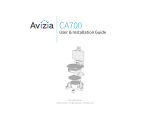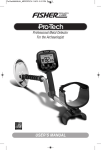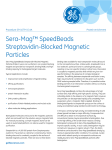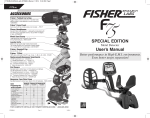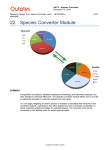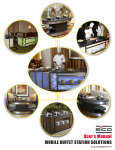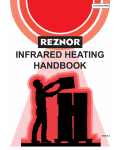Download MIDNIGHT BLACK LIQUID
Transcript
MIDNIGHT BLACK LIQUID Welcome Thank you for choosing BlackWorks®. We fully appreciate that you have a choice when it comes to purchasing your black oxide equipment and supplies. We have made every effort to provide you the highest quality products available in the industry so that the next time you need additional equipment or supplies; we will hopefully be the first ones on your list. PROCESS INSIGHT Before we begin discussing the specifics in the actual operation and procedures of using Midnight Black™ Liquid black oxide solution, we would like to take this opportunity to provide you some background in the black oxide finishing for you first. Whether you have a long history in operating black oxide equipment or just now venturing into the field, we believe that you can gain some knowledge from the information we have provided below. It is not uncommon for those who operate equipment such as a black oxide system everyday get buried in the job and the ritualistic process and will forget or simply overlook some basic observations and techniques, and we hope this will provide some folks a little helpful insight. The following information provides you some comparison between using your Midnight Black™ Liquid black oxide solution or any black oxide solution in an electric heating system compared to a gas heated system. Our Midnight Black™ solution will work just as well in either system, but the information below you may find helpful regardless of the type of heating source you are using. As a prerequisite to properly understanding the difference between a gas heated black oxide system compared to the electrically controlled BlackWorks® system, you need to have some basic understanding of how it all works. First, black oxide and bluing is the same thing, they are used interchangeably depending upon who is saying it. People in the firearms industry referrer to it as Bluing, mainly because most salts are chemically mixed to provide a slight “Blue” color to the steel rather than a blacker looking color. When it comes to industrial applications, it is usually referred to as “Black Oxide” or blackening. Same thing, same process, just called different names. Secondly, the process of black oxide finishing is achieved by submerging an iron steel part into a heated bath of what is commonly referred to as a “Salt” bath. It is referred to as “Bluing Salts” because for one it leaves a “Blue” finish or black as we mentioned earlier and it contains Sodium Nitrate, commonly referred to as “Salt”, as in salt peter, which was used in preserving the ham you had for Christmas dinner or making gunpowder, we prefer the later. The black oxide solution comes in either a powder form or a liquid form. Either form will work for a gas heated or electrically heated system. We however highly recommend our Midnight Black™ in the liquid form due to its longevity and its ease of use in an electric heating system and its extreme black finish properties. This manual and all of its contents are copyright protected 2009, and may not be reproduced without written permission from Blackworks, LLC. ©2009 Blackworks Version 2.0A P/N: BM-MBL-001 -1 - The black oxide solution, regardless of powder or liquid form contains three main ingredients, Sodium Hydroxide (NaOH) (Lye, basically your household drain cleaner as in Drano®), Sodium Nitrate, (NaNO3) and Sodium Nitrite (NaNO2). Along with this chemical mixture, there is also trace amounts of proprietary additives which give you the different colors ranging from light blue to super black. The combination of chemicals mentioned above are then mixed with water (H2O), which is what is then referred to as a “Salt Bath”. The salt bath is typically heated between 285-310 degrees Fahrenheit. At this temperature and chemical mixture, the surface of the iron metal submerged in the bath is converted into magnetite (Fe3O4). It leaves dark or black like cosmetic appearance and a corrosion resistance finish. And thirdly, you also need to understand the basic of boiling points of liquids. As most already know, water (H2O) boils at 212°F at sea level. The salt bath we have been discussing boils between 285°F – 310°F. The reason the salt bath is boiling at say, 290°F and not at 212°F, as compare d to our water is because of the higher boiling points of the 3 main chemical additives. To clarify, if you are boiling a pot of water on the stove at home, the temperature will be 212°F, assum ing you are at sea level. Whether you put 5,000 Btu’s of heat under the water pot or 1,000,000 Btu’s of heat, the water will not boil greater than 212°F, however your pot might vaporize. In regards to your salt bath, the same situation also applies; depending upon the concentration of “Salts” in your salt bath, it will increase or decrease its boiling point. To make this simple, we will assume we want the salt bath mixture to boil at 290°F. That means you have to have the exact combination of salts to water ratio. Keep in mind though, once the mixture begins to boil, no matter how much heat you apply to the mixture, it can’t boil it hotter than 290°F. But, this mixture is not quite like boiling your pot of water. In this situation, as the salt bath begins to boil, the water in the solution begins to evaporate. As the water evaporates, your water to salt solution begins to change immediately. As your salt concentration begins to increase, your boiling point also begins to increase as well. The longer the salt bath boils, the higher the temperature increases due to the evaporation of the water. Not because of more heat, but because the water continues to evaporate, causing the boiling point to increase due to lack of water and higher salt concentration to water ratio. If you were to continue to heat the salt bath solution and not add water it would eventually boil down to nothing except the 3 main chemicals in your salt bath and the temperature would be well over 2,000°F or more. The way we properly control such a chemical solution to maintain a specific boiling point is we continually add water so that the boiling point remains at a specific temperature that we choose. The tricky part on all of this mentioned is the balancing act between the proper heating of the salt solution and also the adding of water to maintain the desired temperature. As you can surely appreciate now, it quickly becomes quite a balancing act to keep the right heat level on the tank and keep adding water so that your salt bath temperature stays at the proper setting. As a normal process of operating a gas heated black oxide tank, the following is the standard operational procedures. We are providing this information to you so that you can have a point of reference in how a standard gas heated tank system works, assuming you may have not operated one before. If you already have had experience in operating a gas heated tank system, please disregard and take a break or feel free to chuckle knowing you have replaced yours with a Blackworks® system. • Turn your gas burner on High under your salt bath tank following the manufactures instructions for your specific make and model. • Keep a close eye on the temperature; it usually takes about 45 minutes for a 5 gal tank to reach pre-operating temperature of 275°F. Make sure you do not leave the tank unattended. Leaving unattended can cause a severe hazard and mess if the tank is allowed to overheat and boil over onto the floor. If allowed to run unattended any longer, you will overheat the salt bath and destroy the salt solution, which usually happens when the salts are operated over 312 degrees Fahrenheit. ©2009 Blackworks Version 2.0A P/N: BM-MBL-001 -2 - • Turn down the gas burner to about 70-75% gas flow, follow your personal experiences as to the exact heat adjustment which will determine your exact setting, which is largely determined as to the amount of cold steel mass you are usually running in your tank. The smaller mass of parts, the less amount of heat you need. More parts, more heat, which is required to more expediently return the salt bath back to its proper temperature once you place your parts into the tank. Keep in mind, don’t run the gas burner hotter than necessary for the parts you are running, doing so will only cause the water in your salt solution to evaporate faster, forcing you to add water sooner than necessary. However, you must have enough heat to quickly return the salt bath to operating temperature after adding your steel parts and to maintain a rolling boil. • You want your salt bath to be at a rolling boil at your preset temperature. For the majority of steels that you run, you will want to have it set at 290°F. • As the temperature rises above 290°F., carefully and slowly add COLD water with an extended handle ladle or cup. Remember, always add COLD water to the salt solution and do it very slowly. Using HOT water or adding the water too quickly can cause violent eruptions of the salt solution, potentially causing severe burns as well as having the salt solution boil over onto the floor. Always wear protective clothing and eye protection when operating a black oxide system, ESPECIALLY WHEN ADDING WATER. • Remember, if your tank is at 290°F when you added your parts into the tank, the temperature will drop rapidly due to the cold parts cooling the salt bath. It will take time for the salt bath to come back up to the 290°F. However, while you are waiting for the salt bath to return to the 290°F., which can be anywhere from 5 min utes to 15 minutes, the water has been continually evaporating from the solution. So, as the salt bath returns to the 290°F., you will notice that it’s not vigorously boil ing like it was before you put the parts in. The reason is that a percentage of the water in the salt bath has evaporated during the short period of time, causing the boiling point to rise. At this time, you want to begin adding water so that your salt bath begins to have a rolling boil but also to maintain your 290°F. Practice over time will allow yo u to get a “Feel” of when and how much water to add. • Keep in mind; this is a continuous balancing act when operating your black oxide tank with gas heating. You have to continuously monitor your bath temperature and the boiling point as well. You want your salt bath to always be boiling and for it to be within your specified temperature range, which is usually +/- 5 degrees of set temperature when operating a manual tank. • Do not place parts into your tank when the salts are not a rolling boil. This can cause greenish and/or reddish residue on your parts. After a tank has been used multiple times, there is a natural build-up of chemicals residue at the bottom of your tank, which is normal from the parts you have placed in the solution. If you place parts in the tank while the solution is boiling, the build-up doesn’t have an opportunity to adhere to the parts being blackened. However, if the solution is stagnant and not vigorously boiling, the build-up residue will commonly adhere to your parts. If you are lucky, it can be wiped off with no ill effects, other times you may have to strip the parts and completely refinish the black oxide finishing, especially if your tank temperature is running on the high side. Now that you have a basic understanding of how a typical gas operated black oxide system operates, let’s move onto the proper use and applications of Midnight Black™ Liquid black oxide solution. ©2009 Blackworks Version 2.0A P/N: BM-MBL-001 -3 - MIDNIGHT BLACK™ LIQUID BLACK OXIDE SOLUTION Introduction Midnight Black™ liquid black oxide solution is a proprietary product, specifically designed for the metal finishing industry. By working with and utilizing the extensive knowledge, skills and years of chemical development of one of the largest chemical laboratories in the industry, we have brought you a product which surpasses all others in achieving a super-black metal finish while providing an extreme reliability to your process. The Midnight Black™ liquid solution provides you and your employees a far more reliable and consistent processing from batch to batch. No longer must you deal with powder flakes which won’t dissolve in the salt bath, leaving contamination on your finished parts. Adding additional liquid solution to your salt bath is quick and easy, providing Zero downtime when needing to add more salts during the middle of a batch run. Midnight Black™ is a liquid black oxide solution which is an oxidizer but does not contain any poisons such as cyanide. It is does not contain any hazardous controlled chemicals such as chlorite or chlorate and is not explosive. It is safely stored without need of special storage requirements. Physical Form • • • • Available in 1, 2 ½, 5 and 55 gallon drums. A clear and odorless liquid with a specific gravity of 1.48 and which is completely water soluble. Boiling point of 270°F Freezing Point: 45°F. DO NOT STORE SOLUTION BELOW 45°F TO PREVENT FREEZING. Applications Midnight Black™ liquid solution is designed for the metal finishing industry. Is for the process of producing a black oxide finish; magnetite (Fe3O4) onto the surface of iron metal (steel). Meets MIL-DTL-13924D for class I black oxide coatings and meets or exceeds all military and government specifications. Is designed to be operated in any size of black oxide processing system from small to large. Works very well in all tank heating systems. Excels in applications which require an extremely “Black” finish on steel rather than a slight blue color. Safety Precautions Midnight Black™ liquid solution is a very strong oxidizer. Proper personal safety equipment must be worn at all times when handling and using this product. Always refer to the Material Safety Data Sheet (MSDS) for specific safety requirements. ©2009 Blackworks Version 2.0A P/N: BM-MBL-001 -4 - Preparation Midnight Black™ liquid is a strong caustic oxidizer. Do not allow the exposure of any items such as zinc plated steel or aluminum with the solution. The black oxide tanks in which you will need to heat the liquid solution in must be fully sealed, leak-proof container made of either plain steel or stainless steel. The seams must be welded, not brazed or soldered. If the solution is exposed to any zinc or aluminum, it will destroy the solution and can cause a violent exothermic (heat) reaction. To apply the black oxide finish on your steel parts they must be fully submerged in the heated salt bath. To do this, you must have a means to lower the part(s) into the bath. This is accomplished either by placing the parts into a wiretype basket or by simply hanging the parts by a mild steel, uncoated wire in the heated tank. Make sure that any metal wire or baskets that you choose for this process is not plated or coated with any type of plating material. It is very common to find heavy mesh or screen at your local hardware store for this process, but you must make sure it is not coated with Zinc or is aluminum rather than steel. If you place any metal with zinc coating into your salt bath, it will destroy your bath and your parts. You can use screen wire or metal which has been plated with zinc as long as you remove the Zinc prior to placing it into your tank. You can use Muriatic Acid (20% Hydrochloric) to remove the zinc plating. If you simply submerge the steel plated items you need to strip the Zinc off of into a solution of the Muriatic acid, it will remove the plating within 30 – 120 seconds usually. A 5 gallon plastic bucket works well for the Muriatic stripping process. Wear personal safety protection when using the Muriatic acid and follow the manufactures directions. You can find Muriatic acid at your local hardware or swimming pool store. Further, we highly recommend that you only use black oxide tanks or metal baskets and wire from reputable black oxide equipment suppliers. There are several sources for these items as well as Blackworks. If you are using a black oxide tank or basket from an unknown source or if they have been used before, we highly recommend you use Muriatic acid to clean the inside of the tanks and the baskets. If your used tanks or baskets contain any residual contamination from prior use, it can contaminate or destroy your new batch of black oxide salts. Also, make sure you have a gallon or more of white vinegar, which you can purchase at your local grocery store. In case of an accidental spill, especially on yourself, you can use the vinegar to neutralize the caustic black oxide solution by directly pouring it on the effected area. Things you need before proceeding: • • • • • • Midnight Black™ liquid, enough to fill your tank within 3 inches of the top. Steel or stainless steel oxide tank Wire basket, wire screen and soft steel wire Face shield, chemical resistant gloves, chemical resistant apron. Close proximity of fresh running water One (1) to two (2) gallons of white vinegar. ©2009 Blackworks Version 2.0A P/N: BM-MBL-001 -5 - Charging your Tanks The next step is to fill your tank(s) with the correct amount of Midnight Black™ liquid black oxide solution. If you are using Blackworks® brand of electric heated tanks, do not fill the tank more than 3 inches from the top. For standard depth black oxide tanks 3 inches from the top is a good starting place. Overfilling the tank will cause an overflow situation when the salt bath begins to boil. You can always add more salts later. When using Midnight Black™ liquid, do not add water when performing a new tank fill. REMEMBER: Always WEAR EYE PROTECTION and the appropriate personal safety items when handling and pouring the black oxide solution. Poor the liquid solution slowly and carefully to prevent splashing onto yourself. Heating the Tank Now that you have your black oxide tank filled to the correct amount of salt solution, you can begin heating the salt bath. If you are using a Blackworks® ICS™ Controller, simply turn the switch to the ON position. If you are operating a gas heated system, light your gas burner and adjust your burner to maximum output. Depending upon your type of heating source and the size of your tank you are usually looking between 15 minutes and 1 hour for your salt bath to come up to pre-operating temperature of 270°F. The Midnight Black™ liquid black oxide solution will begin to boil at around 270°F on a newly charged system. The liquid solution is mixed with about 10% water to allow easier handling and increase the freezing point of the solution. To enable your salt bath to reach its operating temperature of 290°F, you must allow the solution to boil so that the extra water in the solution can evaporate. Once your salt bath has reached the optimal temperature, which is typically 290°F, you are ready to start proce ssing your steel parts. If you are operating a gas heated system, then follow your manufactures recommendations, but for most systems, you will need to turn down the gas burners to about 75% output. If you are using Blackworks® ICS™ Controller, follow the directions contained in your User’s manual relating to your specific model. Black Oxide Processing Procedures 1. Insure your steel parts are completely oil free. They must be free from oil, grease and any other foreign contaminates. If you are using a hot bath cleaner detergent prior to placing your parts into the salt bath, follow the manufactures directions. You can use Acetone as a very effective means of removing any oils on the parts prior to blackening. Caution: If you choose to use Acetone, it is extremely flammable. Do not use this in the proximity of a gas heated device. Do so in a completely separate area for safety. An inexpensive ultrasonic part cleaner using a Citric based cleaner for 5 minutes will also do very well to remove light oils and contaminants from your parts prior to black oxidizing. 2. With your parts either in a metal wire basket or by attaching your parts to a steel wire rinse your parts in a tank or container of clean cold water for about 5-10 seconds. This process will greatly alleviate common issues with potential spots on your final black oxide finish. 3. Slowly lower your parts basket or parts you have on a wire into the salt bath. You want to have your parts at least 1” below the surface of the salt bath solution if possible. Anything less than ¼ below the surface of the salt bath will typically not properly blacken and will require re-finishing that part. ©2009 Blackworks Version 2.0A P/N: BM-MBL-001 -6 - 4. Depending upon your brand of black oxide tanks, you will need to leave the parts in the salt solution between 3 minutes to 20 minutes. The soak times varies greatly due to several factors. If you are using a Blackworks® ICS™ Controller, then you will be looking at between 3-8 minutes, depending upon your part(s) sizes (mass). If you are running a gas heated system, your starting point is going to be at least 10 minutes to as much as 20 minutes soak time. 5. Rinse in COLD water. When lifting your parts out of the black oxide solution and transferring them to cold water, you need to do this procedure in a very quick manner. Your rinse tank or container that you are using for rinsing your black oxide parts must be in close proximity of your salt bath tank. You need to preferably be able to pull the parts out of the heated salt bath and into your cold water rinse tank within 5 seconds from the time they exit the salt bath. You don’t want the heated salt bath solution to dry on the parts. This will cause potential spotting on the newly finished parts. 6. It is recommended that you have a second clean water rinse tank to rinse your parts into again. This is to further remove any residual black oxide solution from your parts. This tank can be heated and will be beneficial when apply a water displacement oil next. However, it is not required to have it heated to achieve the full results of the Midnight Black™ liquid solution. If you are running a lot of parts in a production basis, then we would highly recommend that you are running a hot water bath for your second rinse tank. 7. Spray or dip your newly finished parts with water displacement oil immediately after rinsing your parts in the final water rinse tank. If your parts that you are processing have threaded features or areas of small crevices, then we would suggest that after the initial oiling of the parts that you use compressed air and blow the parts well in those areas. After you have used compressed air on those areas, then again spray or dip the parts into water displacement oil. This will insure that the parts are free of water and if any possible water has remained in an area of the parts processed the water displacement oil with protect those areas. 8. If you have parts which contain small confined features and recessed threaded holes in them, we would recommend that you place the parts into an oven set at 170°F for 20 minutes after you have completely the above steps. The heating process will evaporate any remaining water caught in the part and will allow the water displacement oil to replace those area. This is not required, but if available too you, better guarantees you have a long lasting finish. 9. REPEAT THE ABOVE STEPS FOR NEXT BATCH. Black Oxide Bath Temperature Control After processing your first batch of parts as described above, your salt temperature will have increased due to the evaporation of the water. If you are using a Blackworks® ICS™ Controller with an automatic water addition system, then you won’t need to worry about the controlling the salt bath temperature. It will automatically add water and maintain the exact temperature for you. If you are using a Blackworks® ICS™ BI 200 Controller, then you will need to monitor the control panel LED’s to tell you when to add water. Follow the User’s Manual for specifics in this area. If you are using a gas heated tank system, then you will need to add water when the tank temperature goes beyond 290°F. Remember, if you salt bath is at 290°F, it s hould be at soft rolling boil, if it is not, then you need to add water until it is. Using a long handled ladle or something similar that is made from either uncoated steel or stainless steel, slowly add COLD water to the salt bath solution. CAUTION: When you add water, use only COLD water and do so very slowly. When adding water to the heated salt bath solution, it will spatter, so make sure you are wearing your personal protection items, such as face shield, gloves and apron. ©2009 Blackworks Version 2.0A P/N: BM-MBL-001 -7 - It is recommended that you only add about 8 ounces of water at a time. In a manual water system, you are usually adding up to 8 ounces of water at a time and it takes a couple of minutes to begin registering the temperature accurately on your tank thermometer. If you add too much water at a time, you can cause yourself delays in processing time due to waiting for the excess water to evaporate so that your salt bath can come back to its 290°F operating temperature. Furthermore, if you add excessive water to your salt bath, it will cause a violent boil-over of the salts, creating a potential hazardous mess on the floor. It is a preferred method to add smaller amounts of water frequently rather than add large amounts of water infrequently. You want to strive to keep your salt bath at the same operating temperature at all times and minimize the dramatic up and down temperatures when adding large amounts of water. ©2009 Blackworks Version 2.0A P/N: BM-MBL-001 -8 - Flow-Chart of Black Oxide Process ©2009 Blackworks Version 2.0A P/N: BM-MBL-001 -9 - No Warranty, Expressed or Implied We have attempted to provide you the very best information and procedures that we have found over the years in getting you productive as quickly as possible with the least amount of money and time. However, due to the inherit variables of this type of process, we cannot provide a warranty of any kind, express or implied Proper Disposal Midnight Black™ liquid black oxide solution is a corrosive and high alkaline substance. It contains both Nitrite and Nitrate; which can transfer into your rinse water through normal processing. You may be required to perform neutralization procedures from the waste, which you will need to consult your local, state and/or federal authorities in the proper waste disposal procedures if required in your area ©2009 Blackworks Version 2.0A P/N: BM-MBL-001 - 10 -












